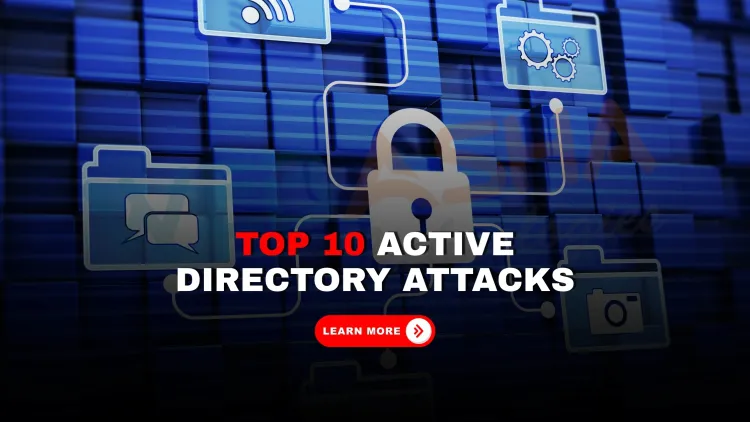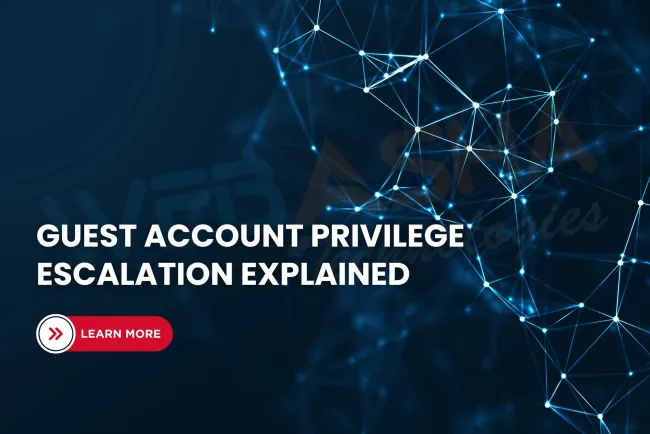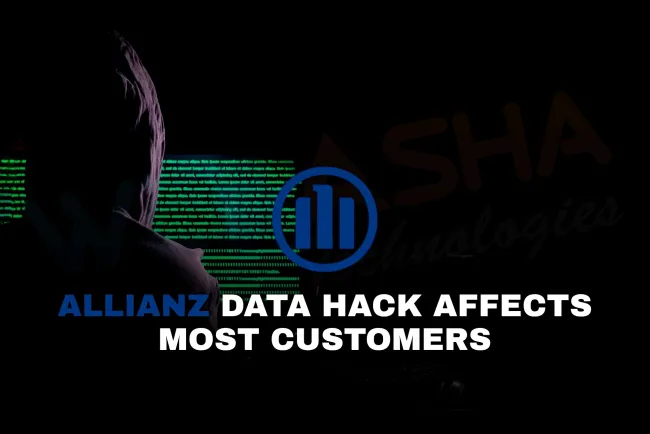Top 10 Active Directory Attack Methods Explained with Real-World Examples and How to Protect Your AD Infrastructure in 2025
Discover the top 10 Active Directory attacks like Kerberoasting, pass-the-hash, and LLMNR poisoning—plus expert tips to secure your AD environment.

Table of Contents
- Introduction
- What Is Active Directory and Why Is It Targeted?
- Top 10 Active Directory Attack Methods (Explained)
- Defense Strategies for Active Directory Security
- Tools Used in These Attacks
- Real-World Example
- Conclusion
- Frequently Asked Questions (FAQs)
Introduction
Active Directory (AD) is the backbone of user authentication, access control, and identity management in most enterprise IT environments. Because it holds the keys to the entire network, attackers often make AD their primary target.
From credential dumping to stealthy reconnaissance, attackers use a variety of methods to gain control over Active Directory. Whether you're a cybersecurity analyst, red teamer, or system admin, understanding these methods is essential to defending your infrastructure.
In this blog, we’ll break down the top 10 most common Active Directory attack techniques—how they work, why they’re dangerous, and how you can defend against them.
✅ What Is Active Directory and Why Is It Targeted?
Active Directory (AD) is Microsoft’s directory service that handles user authentication, permissions, and resource management in Windows-based networks. With access to AD, an attacker can:
-
Move laterally within a network
-
Escalate privileges to domain admin
-
Access confidential files and systems
-
Maintain long-term persistence
Top 10 Active Directory Attack Methods (Explained)
1. Kerberoasting
Kerberoasting allows attackers to request service tickets for SPNs (Service Principal Names) and extract them to brute-force service account passwords offline—without triggering alerts.
-
Tool: Rubeus
-
Mitigation: Use strong, complex service account passwords and monitor ticket requests.
2. Password Spraying
Attackers try a few common passwords across many accounts, avoiding account lockouts. It's a low-and-slow attack that often bypasses brute-force protections.
-
Tool: CrackMapExec, Hydra
-
Mitigation: Enforce MFA and strong password policies.
3. LLMNR & NBT-NS Poisoning
Local network name resolution can be hijacked to steal NTLM hashes. Attackers respond to name resolution requests with malicious answers.
-
Tool: Responder
-
Mitigation: Disable LLMNR and NBT-NS via Group Policy.
4. Pass-the-Hash (PtH)
Instead of cracking passwords, attackers use NTLM hashes to authenticate as users, bypassing traditional login methods.
-
Tool: Mimikatz
-
Mitigation: Use Windows Credential Guard and unique local admin passwords.
5. Default Credentials
Devices, applications, or services running with default usernames and passwords are easy entry points for attackers.
-
Example:
admin:adminorroot:toor -
Mitigation: Change all default credentials before deploying systems.
6. Hard-coded Credentials
Developers sometimes embed credentials in scripts or code repositories. These can be easily extracted and exploited.
-
Risk: Common in DevOps pipelines
-
Mitigation: Use secret management tools (e.g., HashiCorp Vault, AWS Secrets Manager).
7. Privilege Escalation
After gaining a foothold, attackers exploit vulnerabilities or misconfigurations to gain higher-level privileges within the domain.
-
Method: Token impersonation, DACL misconfigurations
-
Mitigation: Regular audits, Group Policy hardening
8. LDAP Reconnaissance
AD can be queried with LDAP to gather information about users, groups, permissions, and trusts—without elevated access.
-
Tool: ldapsearch, PowerView
-
Mitigation: Limit read permissions for standard users and monitor LDAP queries.
9. BloodHound Reconnaissance
BloodHound maps out privilege escalation paths within AD using graph theory—helping attackers visualize the fastest path to domain admin.
-
Tool: BloodHound
-
Mitigation: Reduce attack paths, disable unused permissions, use Azure ATP for detection.
10. NTDS.dit Extraction
The NTDS.dit file stores all domain credentials. If an attacker extracts it from a Domain Controller, they can crack every user’s password offline.
-
Tool: SecretsDump, Mimikatz
-
Mitigation: Restrict physical and remote access to DCs and monitor for unusual Volume Shadow Copy activity.
Defense Strategies for Active Directory Security
| Threat Type | Defense Strategy |
|---|---|
| Credential Theft | Use strong passwords, MFA, and Credential Guard |
| Reconnaissance | Limit anonymous LDAP access and monitor network traffic |
| Privilege Escalation | Enforce least privilege, audit permissions regularly |
| Persistence Techniques | Monitor logins, use EDR, and deploy behavioral analytics |
Tools Used in These Attacks
-
Mimikatz – Credential dumping and token manipulation
-
Rubeus – Kerberos ticket attacks
-
Responder – LLMNR/NBT-NS spoofing
-
BloodHound – AD graph analysis
-
Impacket/SecretsDump – NTDS.dit extraction
Real-World Example
In the SolarWinds attack, attackers gained access to privileged AD accounts through lateral movement and stealthy recon, leveraging techniques like token impersonation and LDAP queries. This shows how a single foothold can lead to widespread compromise in an unprotected AD environment.
Conclusion
Attackers know that Active Directory is the crown jewel of enterprise networks. These 10 attack techniques are not just theory—they’re used every day in real-world intrusions. By understanding how these attacks work, you can take proactive steps to secure your environment.
FAQ
What is an Active Directory (AD) attack?
An Active Directory attack refers to any malicious attempt to exploit vulnerabilities in Microsoft’s identity and access management system used in Windows environments to gain unauthorized access, escalate privileges, or move laterally in a network.
Why is Active Directory a common target for hackers?
Active Directory controls access to critical systems and data. If compromised, attackers can take control of an entire IT infrastructure, making it a prime target for threat actors.
What are the most common types of Active Directory attacks?
Common AD attacks include Kerberoasting, Pass-the-Hash, LLMNR poisoning, NTDS.dit extraction, LDAP enumeration, and Golden Ticket attacks.
What is Kerberoasting in Active Directory?
Kerberoasting is an attack where an attacker extracts service account tickets (TGS) and cracks them offline to retrieve plaintext passwords.
How does the Pass-the-Hash (PtH) attack work?
Pass-the-Hash allows attackers to use stolen NTLM hashes instead of plaintext passwords to authenticate to other systems without cracking the hash.
What is LLMNR and how is it used in AD attacks?
LLMNR (Link-Local Multicast Name Resolution) can be spoofed to intercept authentication requests and capture NTLM hashes, commonly used in credential harvesting.
How can I detect a Kerberoasting attack?
Look for abnormal numbers of Kerberos ticket requests, especially for service accounts with SPNs, and monitor logs for suspicious requests.
What is NTDS.dit and why is it important in attacks?
NTDS.dit is the AD database file that stores all domain user credentials. If attackers extract it, they can crack passwords offline.
Can attackers escalate privileges in Active Directory?
Yes. Attackers often escalate privileges by exploiting misconfigurations, weak passwords, or by using tools like Mimikatz to extract credentials from memory.
What is the Golden Ticket attack in Active Directory?
This attack involves forging Kerberos Ticket Granting Tickets (TGTs) after obtaining the KRBTGT account hash, giving attackers unlimited access.
How does BloodHound help attackers?
BloodHound maps AD relationships and permissions using graph theory, helping attackers find hidden privilege escalation paths.
What is the difference between internal and external AD attacks?
Internal attacks originate from inside the network (e.g., compromised employee devices), while external attacks breach AD from outside, such as via phishing or VPN flaws.
Are default or hard-coded credentials a risk in AD environments?
Yes. These can provide attackers with easy entry points, especially if not rotated or monitored.
What is a Silver Ticket in Active Directory?
A Silver Ticket is forged for a specific service using a service account’s hash, allowing attackers to authenticate as that service.
Can Mimikatz steal passwords from Active Directory?
Yes. Mimikatz is a post-exploitation tool that can extract plaintext credentials, hashes, and Kerberos tickets from memory.
What are best practices for protecting against AD attacks?
Regular patching, strong password policies, disabling LLMNR/NetBIOS, limiting administrative privileges, and monitoring authentication logs are key steps.
How can I protect service accounts in Active Directory?
Use long, complex passwords, remove unnecessary SPNs, apply Least Privilege, and monitor unusual ticket requests tied to those accounts.
What tools do red teams use to test AD security?
Common tools include BloodHound, Mimikatz, CrackMapExec, PowerView, Impacket, and Metasploit modules.
Is Active Directory secure by default?
Not entirely. While AD has built-in security features, it requires proper hardening, auditing, and regular updates to stay secure.
What is LDAP enumeration and why is it dangerous?
LDAP enumeration involves querying the AD database for usernames, group memberships, and permissions—valuable for reconnaissance before an attack.
What is lateral movement in Active Directory attacks?
Lateral movement is when attackers move from one compromised system to another within the network to find high-value targets or escalate privileges.
How do attackers exfiltrate data from AD environments?
After gaining access, attackers use various techniques such as creating new admin accounts, dumping credentials, or using PowerShell for covert data transfers.
What is DCShadow attack in AD?
DCShadow allows attackers to inject malicious changes into the AD database by impersonating a Domain Controller.
Can firewalls stop Active Directory attacks?
Firewalls help reduce attack surface but can't prevent insider threats or credential-based attacks once the perimeter is breached.
What logs should I monitor to detect AD attacks?
Monitor security event logs for unusual login patterns, failed login attempts, ticket requests, and privilege escalation activities.
How often should Active Directory be audited?
At least quarterly, but monthly reviews of high-privilege accounts and daily log monitoring are strongly recommended in critical environments.
What role does PowerShell play in AD attacks?
PowerShell is frequently used for reconnaissance, dumping credentials, and lateral movement due to its deep integration with Windows systems.
What’s the impact of an AD breach on an organization?
A compromised AD can lead to full domain compromise, data breaches, ransomware deployment, or operational downtime.
How do penetration testers simulate AD attacks?
They replicate attacker behavior using tools and techniques like password spraying, SPN enumeration, hash dumping, and privilege escalation methods.
Can cloud-based AD (like Azure AD) be attacked the same way?
Azure AD has different architecture but shares some vulnerabilities. Phishing, misconfigured access policies, and weak MFA implementations are common attack vectors














![Top 10 Ethical Hackers in the World [2025]](https://www.webasha.com/blog/uploads/images/202408/image_100x75_66c2f983c207b.webp)








